How to Build eCommerce Brand Loyalty
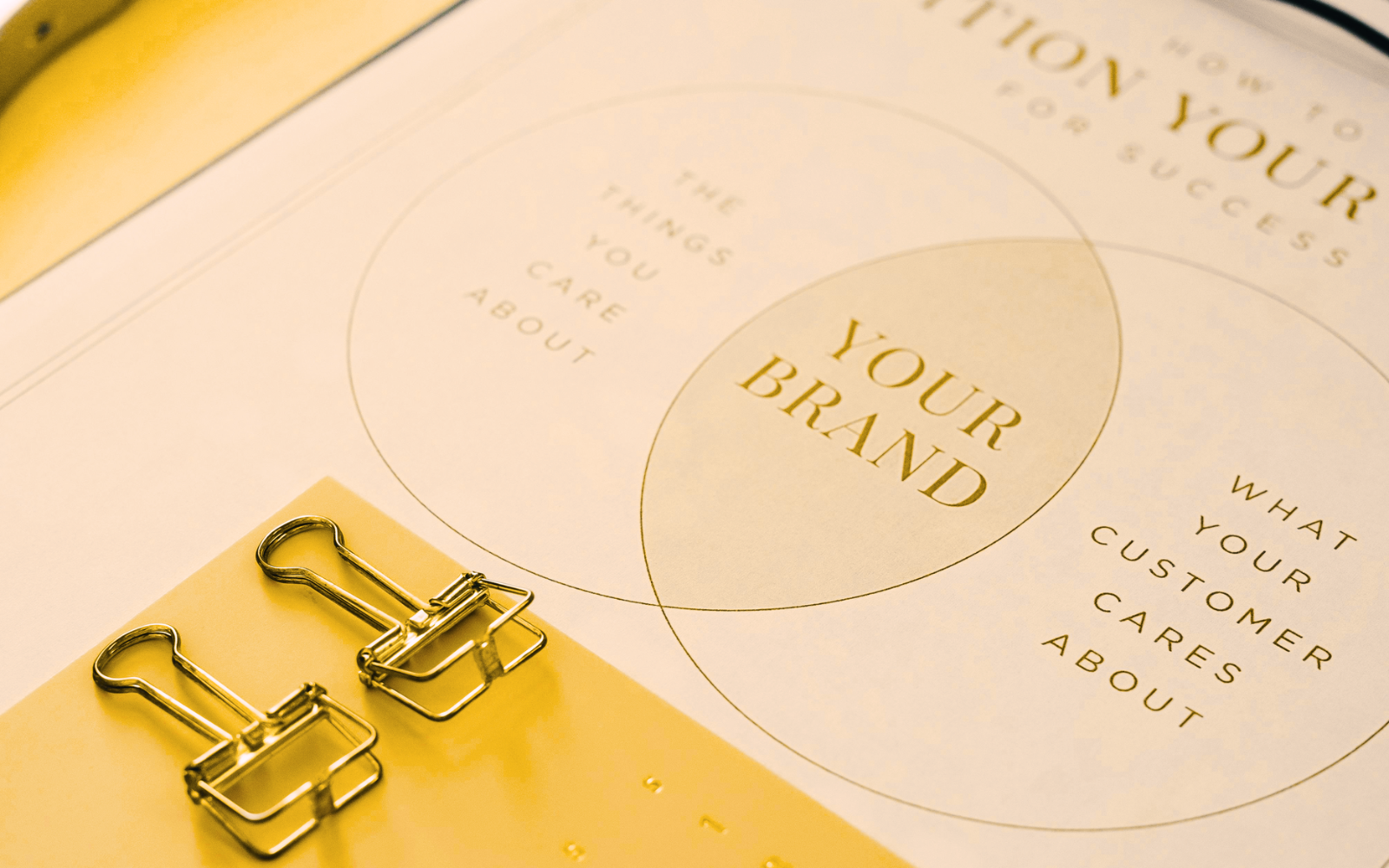
This post was originally published in 2021. We've updated and added to it to provide you with more accurate, up-to-date advice about building brand loyalty for your eCommerce business.
Question: what's the best way to retain eCommerce customers?
For consumer brands, the answer to customer retention often lies in brand loyalty, which touches every aspect of your business—from sourcing materials, product packaging, and pricing to marketing, customer experience, and logistics. Every encounter with your brand represents an opportunity to build—or lose—precious loyalty.
You work extremely hard for each sale, after all. By establishing brand loyalty, you turn one-time customers into repeat buyers. The benefits of this should be obvious: as of 2024, the average customer acquisition cost (CAC) in eCommerce hovers at around $40-86 (depending on the source). That’s why the ability to inspire repeat purchases can make or break a company. Heck, even if you don't sell the kind of products that require repeat purchases, loyalty can unlock a powerful (and free) channel for marketing: word of mouth.
Let's explore.
What is brand loyalty?
Brand loyalty is when consumers have a strong desire to consistently buy products from their favorite brands. This loyalty is often driven by trust in the product's quality, as well as psychological factors, such as feeling connected to the brand's mission or seeing it as the best in its category.
Why is brand loyalty important?
Brand loyalty is important for any company, but particularly for consumer brands that sell products to a specific customer base. These brands tend to have lower profit margins than service-based businesses, meaning loyalty can drastically affect long-term success.
These are key benefits of brand loyalty:
- Increased customer lifetime value (CLV): When customers buy from you again, their CLV increases. For example, a $30-first-time buyer might spend $350 with you later in the year. If your CAC is higher than $30, then you’ve turned a profit on this customer.
- Higher-order values: Loyal consumers are likely to purchase more items from you. They trust your brand, so when you roll out a new product line, your most loyal customers will try it.
- Lower CAC: The cost of acquiring new customers can fall lower, as loyal customers will join your referral program and spread the word about your brand via word of mouth.
- Improved profitability: Because of these transactional and financial benefits, a strong brand can improve your company's profitability. Without brand loyalty, CAC stays high, while CLV and order values remain low.
Examples of brand loyalty programs
Decades-old consumer brands and new eCommerce companies benefit from building customer brand loyalty to grow revenue from repeat buyers.
If you want to know how to build brand loyalty, it’s always helpful to check out examples of companies that are exceptional at creating brand loyalists.
Nike is the top sports brand in the world, even managing to capture Gen Z’s loyalty, while so many other decades-old brands have failed to do so. In addition to churning out iconic but fresh products, the company has a fine-tuned loyalty scheme with exclusive tiers.
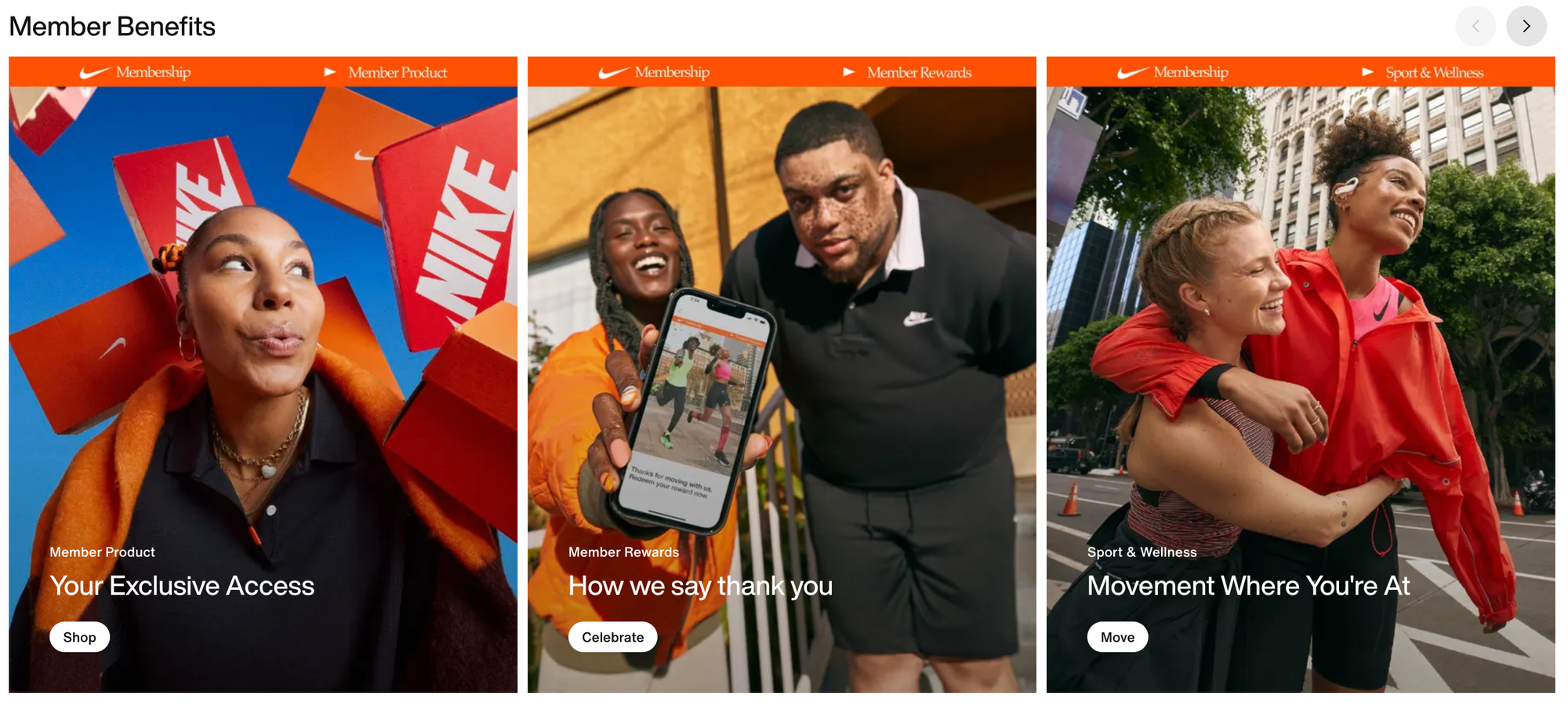
Referral programs are also a great way to create brand awareness and bring in new customers simultaneously by leveraging their existing loyal customer base. With a referral program, companies often reward both the sharer and the person referred with discounts and other incentives.
But how can you have a brand loyalty program if you don’t have any customers?
One eCommerce store found the solution for that.
Girlfriend Collective, an ethically made athleisure brand, encourages brand loyalty with its referral program, brand story, and cheeky copy. When they first launched in 2016, they weren’t sure how to get new customers to trust them, so they gave away 10,000 pairs of eco-friendly leggings for the cost of shipping.
Although a great expense, this "loss-leader" strategy helped ensure they had a profitable business. Many of those initial customers have returned for full-price athleisure wear after their positive experience. Recognizing the cost of acquiring new customers in a crowded market, this marketing strategy recognizes that customer relationships aren't built on a single transaction.
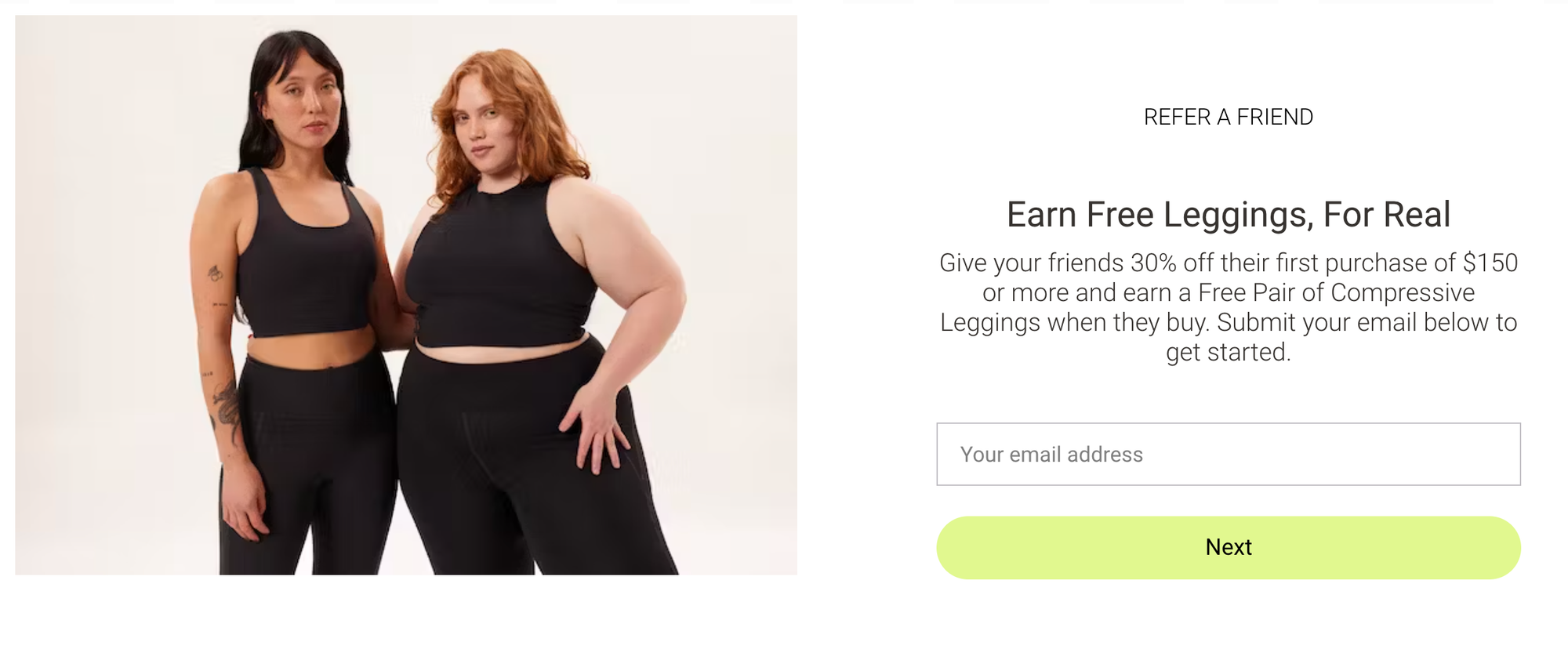
5 factors that influence brand loyalty
Before building brand loyalty, you must understand the factors that influence it.
1. Human psychology
Humans are complicated. So, it’s no wonder that the psychology of brand loyalty is multi-faceted.
There are a few psychological elements that come into play:
- Reciprocity: If you do something nice for someone, they might feel obligated to do something nice for you. Brand loyalty programs that offer bonuses and rewards play on humans’ hardwiring toward reciprocity.
- Trust: Some consumers aren’t easily swayed by flashy marketing campaigns. They might buy from a brand because they trust the product won’t break. (We've written about building trust for eCommerce in a separate article.)
- Belonging: Many consumers want to belong to a certain club. Even brands without recognizable logos can inspire a desire for belonging. For example, many LGBTQ underwear brands have helped people find undergarments that truly fit who they are as a person (not just a body) while also inspiring a feeling of belonging to a special brand. This is often also called brand affinity--the tendency of consumers to identify with your brand and its values.
- Clout: Some consumers just want to show off. They want the best of the best, and they won’t settle for anything less than that.
- Personal connection: Customers make personal connections with brands when they hear the founder’s story, have a big problem solved by one of the brand’s products, or love that brand’s content.
2. Competitive landscape
Even if you're a household name, your brand is not the only option. The strength of your competitors can have a big effect on your brand loyalty.
When there are lots of brands just like yours and many similar products, it’s hard to stand out. On the other hand, you might find your brand at the top of your niche market, only to see everything crash with changing trends.
3. Product quality and relevance
No matter how strong your brand identity and marketing might be, your products must hit the mark, or customers will not stay loyal to your brand. All the marketing efforts in the world can't make up for a poor user experience.
All of these factors can come into play when it comes to maintaining loyalty:
- Materials quality
- Ethical sourcing
- Packaging expectations
- Product effectiveness
- Product longevity
4. Marketing prowess
How good is your marketing at utilizing psychology and emotion? Your marketing campaigns play a big part in brand loyalty. The messaging needs to be on brand, and you also need to be able to retain customers. We’re talking about email nurturing campaigns, retargeting, and remarketing.
At Nori, we find the best way to inspire brand loyalty is to drive home the uniqueness of our product and the fact that it is a cut above its market competitors. Nori was created because other steamers on the market were faulty, leaky, and could not consistently perform to the standards we should expect of our home goods. We often communicate the messaging to our customers via email, social media, and other digital marketing channels so that it can reach the widest possible audience.
— Annabel Love, co-founder & COO of Nori
Check out how Nori communicates their product differentiators with potential customers on the home page of their website:

5. Customer and employee interactions
Your customer service affects brand loyalty too. 89% of companies say that great customer service plays a major part in customer retention. And consumers agree. 65% have switched to another brand because of a poor experience.
4 types of brand loyalty
Generally speaking, there are four different types of brand loyalty. In essence, these are levels on the path to the fanatical loyalty any brand builder wants.
1. Brand recognition
The 10 most recognizable brands in the world are:
- Apple
- Amazon
- Microsoft
- Coca-Cola
- Samsung
- Toyota
- Mercedes-Benz
- McDonald’s
- Disney
However, that doesn’t mean every consumer is loyal to these brands. We can all think of family and friends who wouldn’t buy from some of these brands.
However, recognition is an important first step in the journey towards loyalty.
For example, when consumers shop on Amazon, they may not pay attention to the third-party brand they buy from. Unless you add enhanced brand content to your Amazon product listings and use branded product packaging, you won’t build recognition, and the consumer might think the product was created by Amazon. Without that recognition, you can’t build preference or loyalty.
With distinctive branding for your products and product imagery, you can build that recognition on any marketplace, distribution channel, or platform. Blooming Bath does this well. Amazon doesn’t swallow up their brand on its brand page and product listings.
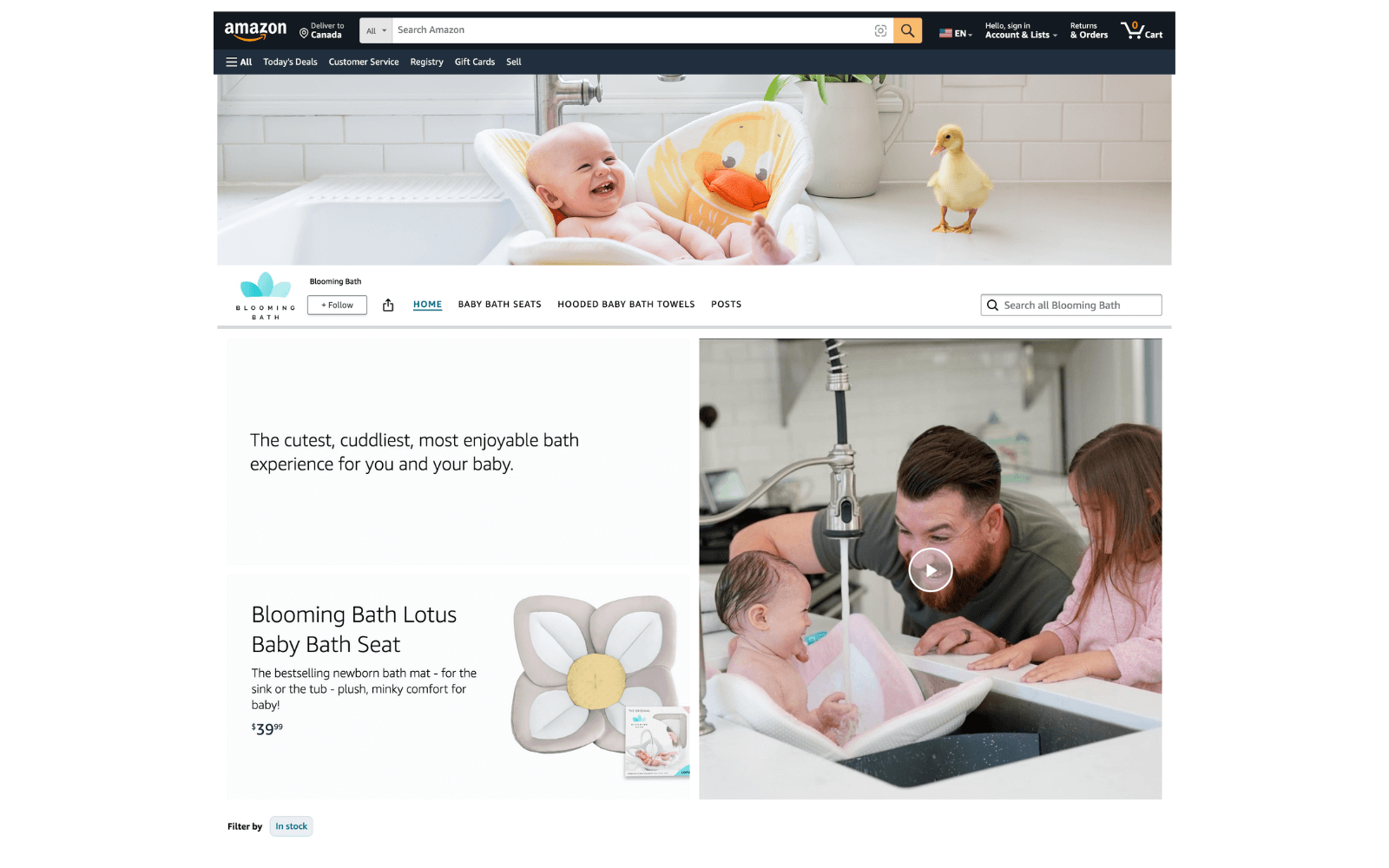
2. Loyalty to multiple brands in one category
Customers might be fiercely loyal to your brand—and other brands that sell the exact same thing. For example, you might stick to Shark or Dyson as your vacuum brand but purchase clothes and food from many different brands.
Some eCommerce stores don’t try to fight this and instead offer multiple brands in one place. Asos is a great example of this. They sell their own product lines and over 850 other brands, essentially becoming both a clothing brand and a clothing marketplace.
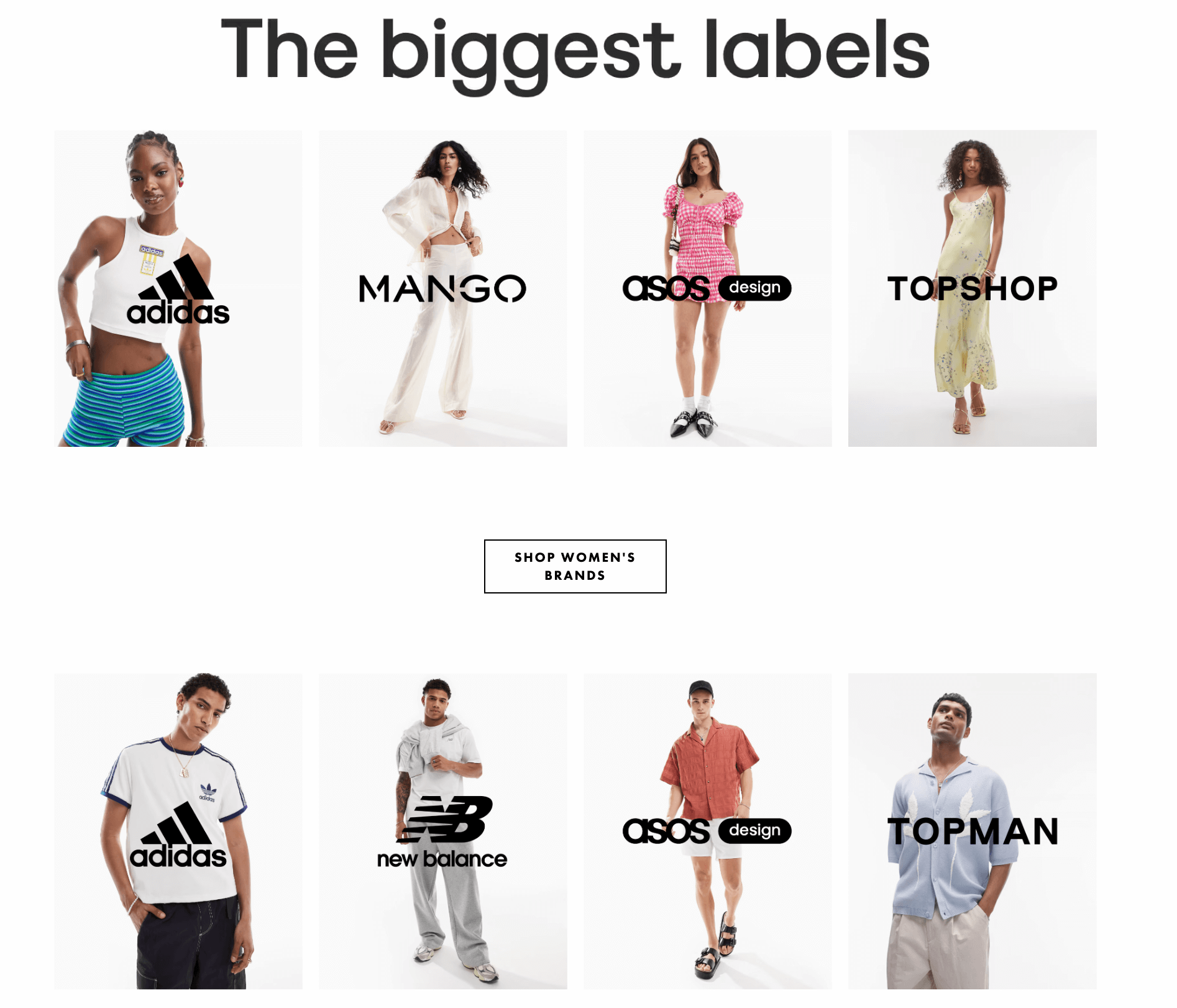
3. Brand preference over other brands
Next, there is brand preference. This means that a consumer prefers your brand over any other in that product category, but they might purchase other brands in a pinch.
For example, a customer might only buy SugarBearHair gummy vitamins from their own eCommerce store and from Target.com. But, when buying a dress from Target.com, she might throw a different brand of gummies into her cart to qualify for free shipping because SugarBearHair is unavailable.
4. Complete brand loyalty
At the highest level, there’s complete brand loyalty. A customer will not switch to another brand, even when your products are all sold out. Instead, they’ll sign up to be notified when the item comes back in stock, and they’ll wait to make their purchase until then. Apple, with its fans lined up for the newest release, is a prime example. But other brands can achieve this too, especially beauty and personal care products. Once people find what works best for their skin or hair type, they might not want to switch.
14 powerful strategies for your eCommerce brand
Brand loyalty isn’t like winning the lottery. You can engineer it. You can build brand loyalty from the ground up by taking in customer feedback and connecting with your audience at every turn. Try these 14 strategies to make this a reality.
1. Connecting with your target audience
Standing out amongst competitors and legacy brands is a must. Younger generations tend to want to do things differently. For example, Millennials flocked to Klean Kanteen water bottles (unlike the plastic single-use bottles of their childhood), while Hydroflask grew in popularity among Gen Z, who wanted stainless steel water bottles but wouldn’t be caught dead with the same brand that Millennials love.
On another note, your product might connect with a specific niche of consumers instead of a specific demographic. For example, your audience might be hobbyists like disc golf players or quilters.
Money is also a factor. Middle-class shoppers might be more loyal to high-quality and reasonably priced brands, while wealthier shoppers are willing to pay a premium for a luxury brand.
2. Eliciting emotional responses
Emotion is a major part of branding. And psychological studies have proven that first impressions are hard to shake. That’s why every element of your brand, from marketing to product to delivery, needs to reinforce the emotions you want your customers to feel. The top emotions you should appeal to are belonging, happiness, fear, anger, sadness, and pride.
One brand can appeal to multiple emotions in different campaigns, so long as this connects with the overall promise of the brand. For example, the #LikeAGirl campaign by Always showed the difference between how young girls portray “run like a girl” and how older people and boys portray this phrase. The young girls ran quickly and confidently while everyone else play-acted what was essentially an insult. It created anger, sadness, and pride in viewers identifying as women while solidifying the brand’s promise to empower women through its products and content.
3. Consumer trend watching
You don’t want to be one of those brands behind the trends, like J.C. Penney or Pier 1. You must be proactive and on top of consumer trends to keep up. Look to the media publications and platforms relevant to your brand for consumer insights.
Pinterest Trends and Google Trends can show you which searches are descending and which are rising. For more general trend watching, you could purchase consumer trends reports from a service like Research and Markets or Statista.
4. Focus groups and product testing
Knowing consumer trends isn’t enough. You also need to know how your target consumers react to your specific product. To get their feedback, you could send prototypes to customers you have a relationship with.
Or, you could enlist the services of a company like Veylinx, a consultancy that runs auctions where consumers bid on product versions that they like better with their real money. Companies like Sephora and The Body Shop use Veylinx to run pricing tests and determine which test products should be launched.
5. Branded post-purchase experiences
A branded post-purchase experience is a must. So, consider creating a branded order tracking page that customers can view at any time to check the status of their order. You could automatically load this page upon order completion and include it in the confirmation email. This helps solidify brand recognition while showcasing your company as modern, transparent, and helpful.

You can add whatever you want to this page, such as recommended products or more information about how your company gives back.
6. Amazing customer service
As Jeff Bezos has said, “The best customer service is if the customer doesn't need to call you, doesn't need to talk to you. It just works.”
Your customer service should be:
- Multichannel: Help customers where they want to be helped, whether they reply to an email, submit a chat message, or ask a question on social media.
- Self-service: Create more self-service support experiences, like a branded order tracking page for checking order status and a customer returns portal for printing return labels within your company policy (meaning for old or clearance orders, labels can’t be printed).
- Fast: Use help desk software with customer data variables and response templates to respond to customer issues quickly, accurately, and with on-brand messaging.
7. Customer-friendly policies
75% of US consumers expect free shipping. And 96% of shoppers are likely to shop at an online retailer again if they’re satisfied with the returns process. Aim to offer free shipping for orders over a certain amount, and if you can, offer free returns, or at least a low-cost flat-rate fee.
8. Community building
You don’t need to code a forum from scratch to build a community. Today, community building simply means solving problems for your customers beyond fulfilling orders, such as answering their questions, being helpful, and providing a space where customers can hang out together. Social media posts, especially live videos, can offer all of this. Just make sure to engage in the comments section.
Social commerce platforms, like TikTok Shop, can help you produce compelling videos with the help of your community through influencer marketing and live video feeds.
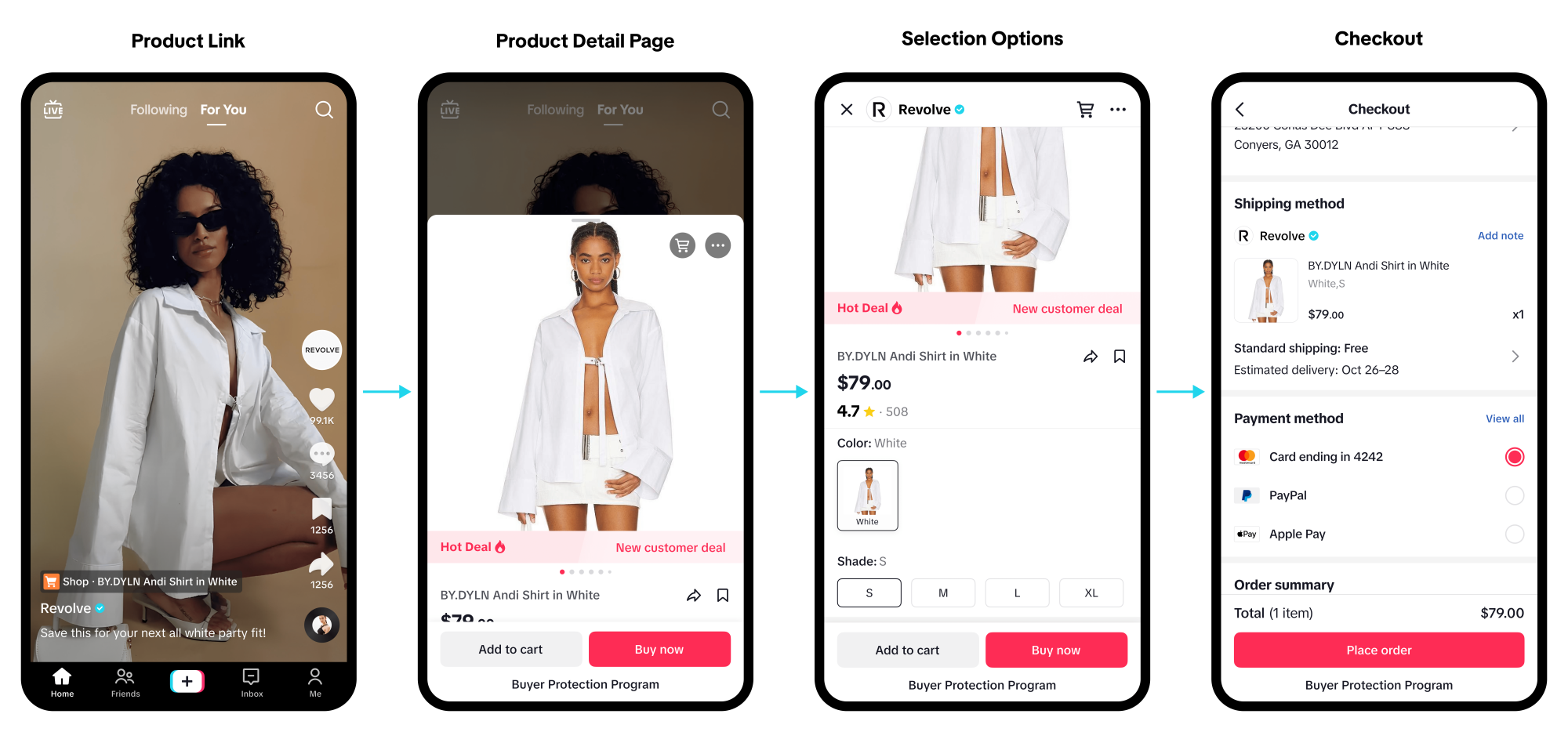
9. Social monitoring and customer feedback reviewing
What are your followers, fans, and customers saying about you? Use a social listening platform like Brandwatch or Mediatoolkit to pay attention to social media mentions and review sites. Learn from the feedback to improve your products, customer service, and marketing.
“Anticipate customer's needs and possible frustrations, and provide easy and accessible channels of communication. By being available, listening, and repeating back what customers are explaining to you, you are showing them that you see their concerns. You have to make their problem your problem and take ownership of the customer’s question. Avoid any assumptions and make your customers a priority.”
— Brandon Monaghan, co-founder of Miracle Brand
10. Highly personalized marketing campaigns
70% of Millennials are frustrated with brands that send emails that are irrelevant to them. And a whopping 47% of online shoppers will check Amazon if the site they’re on doesn’t provide relevant product suggestions. To increase customer loyalty, you can personalize emails, landing pages, pop-ups, and banners with AfterShip.
11. Incentivized referral programs
Loyal customers can be a source of new customers. In today’s world, word of mouth is still a powerful source. Incentivize customers to share your products, giving you even more word of mouth. With AfterShip Affiliates, you can create different kinds of rewards, like discounts, free products, or other bonuses when customers share your business or earn you a sale.

12. Giving back to aligned causes
Today’s consumers demand ever-higher levels of corporate social responsibility (CSR). Giving back is a clear way to make good on CSR promises while inspiring brand loyalty. You could donate one-for-one like Toms and Warby Parker or use a platform like Givz to allow customers to donate to a charity.
13. Create your own brand loyalty program
As an eCommerce business, you can create your own loyalty program to inspire more repeat purchases.
"For Internet Gardener, a client of ours who is a retailer of premium outdoor garden products, we implemented a loyalty points system. Similar to when you go to Starbucks, and they stamp your loyalty card, and after you buy 7 coffees, you get your 8th free. Taking inspiration from this, we offered customers different incentives based on how much they spent with the store. This, in turn, incentivizes the customer to come back to the store and to make their subsequent purchase from them as they'll benefit more in the long run by discount, store credit or free products."
— Founder and Director of eCommerce digital marketing agency Contrast Digitaldrop-off
14. Regularly measure brand loyalty
Figuring out how to measure brand loyalty isn’t easy. However, as a digital brand, it’s certainly easier for you than a brick-and-mortar store. With tracking and cookies, as well as user accounts, you can collect data that paints a picture of your brand loyalty.
Here are some metrics you can track:
- Percentage of return traffic to your website
- Website user drop-off
- Customer lifetime value (CLV)
- Order value for repeat customers versus new customers
- Customer retention in terms of what percentage of customers buy from you a second, third, fourth time, etc.
Essential brand loyalty statistics
Brand loyalty comes down to a few important factors. Consumers want to feel understood. They want to use products that people they know like. And they will buy more when emotion is involved. Aria’s research concluded that emotion is the biggest driver of loyalty in most industries.
81% of customers trust recommendations from family and friends over what companies recommend. This shows how important it is to set up an effective referral program.
Emotionally connected customers spend twice as much with a company they are loyal to versus a satisfied customer who is not emotionally motivated.
How brand loyalty has changed (and is still changing)
Some say that brand loyalty is dead. Hundreds of Victoria’s Secret and Forever 21 stores have closed because they failed to connect with Gen Z like they did with previous generations.
But Gen Z, like other generations before it, simply has a different set of ideals and expectations that some brands have failed to meet. “If a brand does not authentically live the values it portrays, it won’t just connect to this audience. The audience could turn on it,” Marcy Campbell, PayPal Vice President and General Manager of North America and Australia, told RetailDive. On the other hand, baby boomers have prioritized convenience, members-only benefits, and VIP experiences.
Brand loyalty is changing because it always changes. During the pandemic, for instance, 56% of consumers tried a new retailer. Each generation, demographic, niche, and world event will have unique emotions and demands to unlock. The secret is making sure your brand knows how to find the keys.
Summary: How to Build Brand Loyalty 101
Brand loyalty might be difficult to build, but it's always worthwhile. Loyal customers help you recover your customer acquisition costs and create a highly profitable business.
In summary, you can increase brand loyalty by:
- Connecting with your target audience
- Eliciting emotional responses
- Keeping up with consumer trends
- Running focus groups and product testing
- Optimizing branded post-purchase experiences
- Offering amazing customer service
- Creating customer-friendly policies
- Building community
- Social listening and reviewing customer feedback
- Running highly personalized marketing campaigns
- Creating incentivized referral programs
- Giving back to aligned causes
- Creating your own brand loyalty program
- Tracking brand loyalty
With an effective brand loyalty strategy, you can create momentum to drive your business to success.

